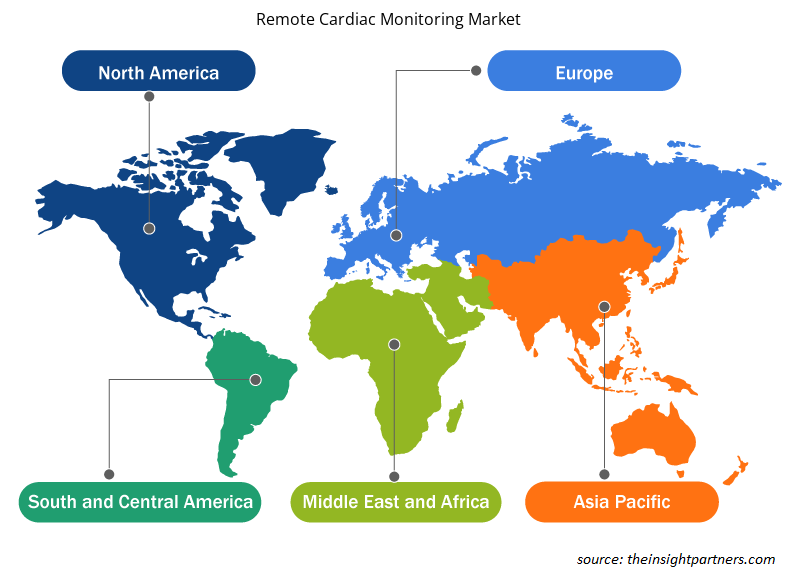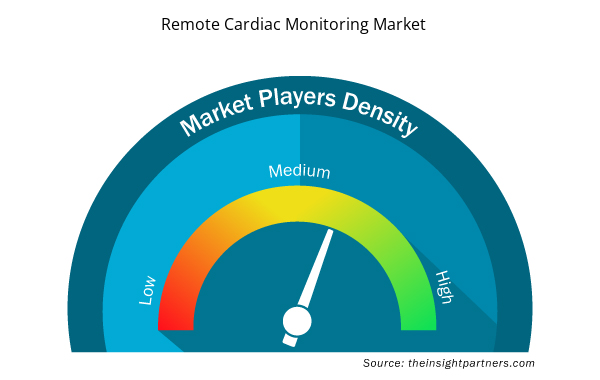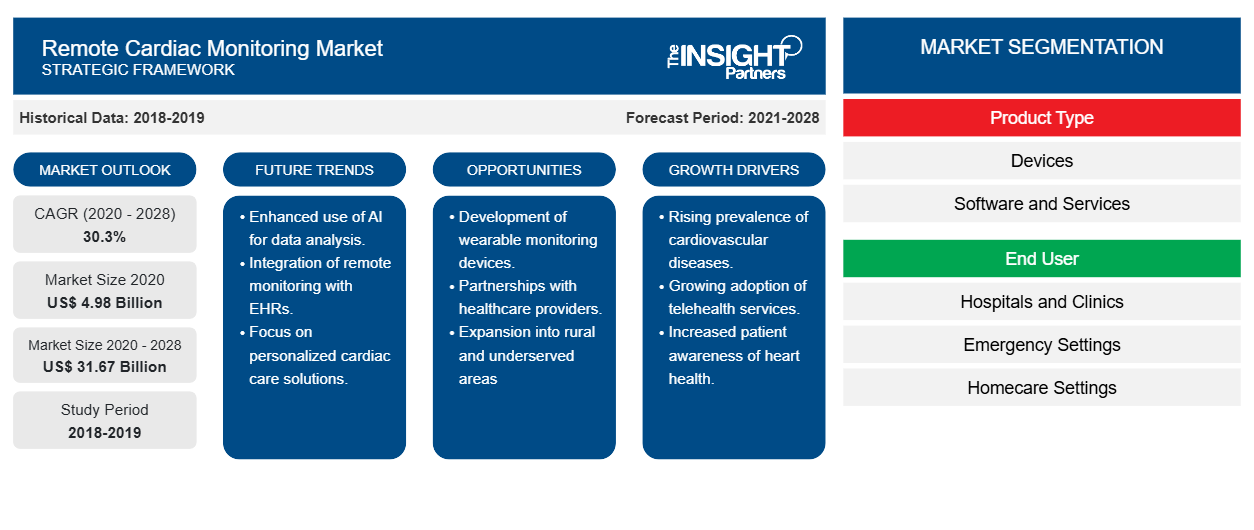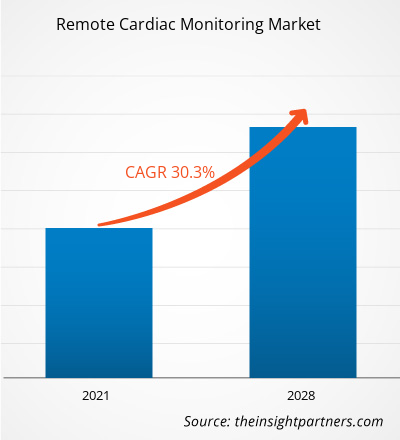Der Markt für die Fernüberwachung der Herzfunktion soll von 4.976,40 Millionen US-Dollar im Jahr 2021 auf 31.671,69 Millionen US-Dollar im Jahr 2028 anwachsen; von 2021 bis 2028 wird mit einer durchschnittlichen jährlichen Wachstumsrate von 30,3 % gerechnet.
Geräte zur Fernüberwachung des Herzens ermöglichen eine kontinuierliche Überwachung der elektrischen Aktivitäten des Herzens auch außerhalb von Krankenhäusern. Sie ermöglichen auch die Überwachung per Elektrokardiogramm (EKG) zu Hause bei Patienten mit Verdacht auf Herzrhythmusstörungen oder bei denen das Risiko besteht, dass diese auftreten. Die Überwachung kann auch durchgeführt werden, wenn die Patienten mit ihren täglichen Aktivitäten beschäftigt sind. Einer der wichtigsten Vorteile der Fernüberwachung des Herzens durch Geräte besteht daher darin, dass sie die Notwendigkeit routinemäßiger Arztbesuche verringert. Geräte wie Herzschrittmacher und implantierbare Kardioverter-Defibrillatoren werden in minimalinvasiven Verfahren in das Herz des Patienten implantiert. Ein Sender, der synchron mit dem Gerät arbeitet, übernimmt die Datenübertragung. Faktoren wie die Zunahme von Herz-Kreislauf-Erkrankungen und kontinuierliche Entwicklungen im Bereich der Telemedizin fördern das Wachstum des Marktes für die Fernüberwachung des Herzens . Bedenken hinsichtlich des Datenschutzes hemmen jedoch das Marktwachstum.
Passen Sie diesen Bericht Ihren Anforderungen an
Sie erhalten kostenlos individuelle Anpassungen an jedem Bericht, einschließlich Teilen dieses Berichts oder einer Analyse auf Länderebene, eines Excel-Datenpakets sowie tolle Angebote und Rabatte für Start-ups und Universitäten.
- Holen Sie sich die wichtigsten Markttrends aus diesem Bericht.Dieses KOSTENLOSE Beispiel umfasst eine Datenanalyse von Markttrends bis hin zu Schätzungen und Prognosen.
Markteinblicke
Zunahme von Herz-Kreislauf-Erkrankungen
Durch Patientenfernüberwachung (RPM) können Patienten ihre Gesundheit besser kontrollieren, indem sie sich stärker an ihrer Gesundheitsversorgung beteiligen. Die American Heart Association unterstützt Initiativen, die die Entwicklung und Nutzung evidenzbasierter Technologien zur Patientenfernüberwachung fördern. Laut der Weltgesundheitsorganisation (WHO) gehören Herz-Kreislauf-Erkrankungen (CVDs) zu den häufigsten Todesursachen weltweit, und jedes Jahr erleiden etwa 30 Millionen Menschen einen Schlaganfall. Laut der American Heart Association leidet fast die Hälfte aller Erwachsenen in den USA an einer Art von CVD. Darüber hinaus werden bis 2035 voraussichtlich mehr als 130 Millionen Menschen, d. h. 45,1 % der US-Bevölkerung, an einer Art von CVD leiden. Berichten der European Society of Cardiology zufolge verursachen CVDs in Europa 3,9 Millionen Todesfälle und in der Europäischen Union (EU) über 1,8 Millionen Todesfälle. Darüber hinaus sind sie für 45 % aller Todesfälle in Europa und 37 % aller Todesfälle in der EU verantwortlich. Die durch Herz-Kreislauf-Erkrankungen verursachten Todesfälle in den Ländern des asiatisch-pazifischen Raums reichen von weniger als 20 % in Ländern wie Thailand, den Philippinen und Indonesien bis zu 20–30 % in den Städten Chinas, Hongkongs, Japans, Koreas und Malaysias. Darüber hinaus weisen Neuseeland, Australien und Singapur, um nur einige zu nennen, relativ hohe Raten von 30–35 % auf.
Bluthochdruck ist ein erheblicher Risikofaktor für Herz-Kreislauf-Erkrankungen. Die altersbereinigte Prävalenz von Bluthochdruck unter Erwachsenen in den USA beträgt ~35 %, was einer Bevölkerung von ~85 Millionen entspricht. Bis 2035 werden ~42 % der Erwachsenen des Landes, also weitere 27 Millionen, an dieser Krankheit leiden. Die Kostenbelastung durch Bluthochdruck für die Volkswirtschaften steigt ebenfalls und die Kosten werden wahrscheinlich von ~70 Milliarden US-Dollar im Jahr 2015 auf ~150 Milliarden US-Dollar bis 2035 steigen. Die Fernüberwachung von Patienten kann ein wichtiger Weg sein, um die Kontrolle des Bluthochdrucks zu verbessern und die wirtschaftliche Belastung durch längere oder häufige Krankenhausaufenthalte infolge akuter Ereignisse im Zusammenhang mit Bluthochdruck zu verringern. Untersuchungen haben gezeigt, dass RPM (Fernüberwachung von Patienten) den systolischen Blutdruck (SBP) und den diastolischen Blutdruck (DBP) im Vergleich zur üblichen Behandlung und Selbstüberwachung allein deutlich senken kann. Laut einigen nicht randomisierten Studien können RPM-Geräte die Ergebnisse verbessern, indem sie eine genaue und frühzeitige Erkennung ermöglichen und die Gesamtmortalitätsrate sowie die Zahl der Krankenhausaufenthalte senken. Aktuelle klinische Richtlinien empfehlen dringend den Einsatz von RPM zur Erkennung von Vorhofflimmern (AF) sowohl bei Schlaganfall- als auch bei Nicht-Schlaganfallpatienten.
Produkttypbasierte Einblicke
Basierend auf dem Produkttyp ist der Markt für die Fernüberwachung des Herzens weiter in Geräte, Software und Dienste unterteilt. Das Gerätesegment hatte 2021 einen größeren Marktanteil und dürfte im Prognosezeitraum eine höhere CAGR verzeichnen.
Endbenutzerbasierte Erkenntnisse
Basierend auf dem Endnutzer ist der Markt für die Fernüberwachung des Herzens in Krankenhäuser und Kliniken, Notfalleinrichtungen, häusliche Pflegeeinrichtungen und andere unterteilt. Das Segment Krankenhäuser und Kliniken würde 2021 den größten Marktanteil halten, während der Markt für das Segment Notfalleinrichtungen im Prognosezeitraum voraussichtlich mit einer durchschnittlichen jährlichen Wachstumsrate von 31,60 % wachsen wird.
Verschiedene auf dem Markt für die Fernüberwachung der Herzfunktion tätige Unternehmen verfolgen Strategien wie Produkteinführungen, Fusionen und Übernahmen, Kooperationen, Produktinnovationen und die Erweiterung ihres Produktportfolios, um ihre Präsenz weltweit auszubauen, ihren Markennamen zu wahren und die wachsende Nachfrage der Endbenutzer zu erfüllen.
Regionale Einblicke in den Markt für Fernüberwachung des Herzens
Die regionalen Trends und Faktoren, die den Markt für Herzfernüberwachung im Prognosezeitraum beeinflussen, wurden von den Analysten von Insight Partners ausführlich erläutert. In diesem Abschnitt werden auch Marktsegmente und Geografie für Herzfernüberwachung in Nordamerika, Europa, im asiatisch-pazifischen Raum, im Nahen Osten und Afrika sowie in Süd- und Mittelamerika erörtert.

- Erhalten Sie regionale Daten zum Markt für Herzfernüberwachung
Umfang des Marktberichts zur Fernüberwachung des Herzens
| Berichtsattribut | Details |
|---|---|
| Marktgröße im Jahr 2020 | 4,98 Milliarden US-Dollar |
| Marktgröße bis 2028 | 31,67 Milliarden US-Dollar |
| Globale CAGR (2020 - 2028) | 30,3 % |
| Historische Daten | 2018-2019 |
| Prognosezeitraum | 2021-2028 |
| Abgedeckte Segmente | Nach Produkttyp
|
| Abgedeckte Regionen und Länder | Nordamerika
|
| Marktführer und wichtige Unternehmensprofile |
|
Marktteilnehmerdichte: Der Einfluss auf die Geschäftsdynamik
Der Markt für Remote Cardiac Monitoring wächst rasant, angetrieben durch die steigende Nachfrage der Endnutzer aufgrund von Faktoren wie sich entwickelnden Verbraucherpräferenzen, technologischen Fortschritten und einem größeren Bewusstsein für die Vorteile des Produkts. Mit steigender Nachfrage erweitern Unternehmen ihr Angebot, entwickeln Innovationen, um die Bedürfnisse der Verbraucher zu erfüllen, und nutzen neue Trends, was das Marktwachstum weiter ankurbelt.
Die Marktteilnehmerdichte bezieht sich auf die Verteilung der Firmen oder Unternehmen, die in einem bestimmten Markt oder einer bestimmten Branche tätig sind. Sie gibt an, wie viele Wettbewerber (Marktteilnehmer) in einem bestimmten Marktraum im Verhältnis zu seiner Größe oder seinem gesamten Marktwert präsent sind.
Die wichtigsten auf dem Markt für die Fernüberwachung der Herzfunktion tätigen Unternehmen sind:
- OSI Systems, Inc.
- GE-Gesundheitswesen
- Biotronik Se
- Nihon Kohden Corporation
- Abbott Laboratories
Haftungsausschluss : Die oben aufgeführten Unternehmen sind nicht in einer bestimmten Reihenfolge aufgeführt.

- Überblick über die wichtigsten Akteure auf dem Markt für Herzfernüberwachung
Markt für Herzfernüberwachung – nach Produkttyp
- Geräte
- Software
- Dienstleistungen
Markt für Remote-Herzüberwachung – nach Endbenutzer
- Krankenhäuser und Kliniken
- Notfalleinstellungen
- Einstellungen für die häusliche Pflege
- Sonstiges
Markt für Herzfernüberwachung – nach Geografie
- Nordamerika
- UNS
- Kanada
- Mexiko
- Europa
- Frankreich
- Deutschland
- Italien
- Vereinigtes Königreich
- Spanien
- Restliches Europa
- Asien-Pazifik (APAC)
- China
- Indien
- Südkorea
- Japan
- Australien
- Restlicher Asien-Pazifik-Raum
- Naher Osten und Afrika (MEA)
- Südafrika
- Saudi-Arabien
- Vereinigte Arabische Emirate
- Restlicher Naher Osten und Afrika
- Süd- und Mittelamerika (SCAM)
- Brasilien
- Argentinien
- Restliches Süd- und Mittelamerika
Firmenprofile
- OSI Systems, Inc.
- GE-Gesundheitswesen
- Biotronik Se
- Nihon Kohden Corporation
- Abbott Laboratories
- Boston Scientific ist eine gemeinnützige Organisation, die sich auf die Förderung von Wissenschaft und Technologie spezialisiert hat. Sie ist die erste in den USA und hat 19
- Koninklijke Philips NV
- Honeywell International, Inc.
- AMC Gesundheit
- Historische Analyse (2 Jahre), Basisjahr, Prognose (7 Jahre) mit CAGR
- PEST- und SWOT-Analyse
- Marktgröße Wert/Volumen – Global, Regional, Land
- Branche und Wettbewerbsumfeld
- Excel-Datensatz



Report Coverage
Revenue forecast, Company Analysis, Industry landscape, Growth factors, and Trends

Segment Covered
This text is related
to segments covered.

Regional Scope
North America, Europe, Asia Pacific, Middle East & Africa, South & Central America

Country Scope
This text is related
to country scope.
Häufig gestellte Fragen
Global remote cardiac monitoring market is segmented by region into North America, Europe, Asia Pacific, Middle East & Africa and South & Central America. In North America, the U.S. is the largest market for remote cardiac monitoring. The US is estimated to hold the largest share in the remote cardiac monitoring market during the forecast period. The growth of the market can be because of the rising investments in cardiology informatics, connected devices, and mobile solutions for advanced cardiac care, increasing product launches, and R&D activities to develop advanced remote cardiac monitoring devices. In addition, technologically advanced products are likely to stimulate the growth of remote cardiac monitoring market in North America. On the other hand, growing emphasis on cost optimization, focus on streamlining of clinical processes, increasing number of clinical trials, rise in the government initiatives, growing number of research and development activities, and rising number of product launches and approvals in the Asia Pacific is expected to account for the fastest growth of the region during the coming years.
The remote cardiac monitoring market majorly consists of the players such OSI Systems, Inc., GE Healthcare, Biotronik Se, Nihon Kohden Corporation, Abbott Laboratories, Boston Scientific Corporation, Koninklijke Philips N.V., Honeywell International, Inc. and AMC Health among others.
The hospitals and clinics segment dominated the global remote cardiac monitoring market and accounted for the largest revenue share of 37.60% in 2021.
The device segment dominated the global remote cardiac monitoring market and held the largest revenue share of 58.53% in 2021.
Remote cardiac monitoring is the constant monitoring of electrical activities of the heart, which practices place outside hospitals. The monitoring can also be performed while the patient is doing the day-to-day activities. Devices like pacemakers and implantable cardioverter-defibrillator are placed with the patient through minimally invasive procedures. The transmission of data takes place within a transmitter that works in sync with the device. Remote cardiac monitoring technologies allow home electrocardiographic (ECG) monitoring of patients with suspected cardiac arrhythmias or at risk for developing arrhythmias. One of the most important benefits of remote cardiac device monitoring is that it cuts down on routine doctor visits. Without remote monitoring, patients visited the doctor every three to six months (depending on device type) for a data download. With remote monitoring, the number of visits have dropped to one to two per year. Remote cardiac device monitoring is a fantastic way to follow patients and it has always been important, but it’s especially important in this era of COVID-19.
Key factors that are driving the growth of this market are increase in incidence of cardiovascular diseases, continuous developments in telemedicine approach, and rising investment in research and development are expected to boost the market growth for the remote cardiac monitoring over the years.
Trends and growth analysis reports related to Life Sciences : READ MORE..
The List of Companies - Remote Cardiac Monitoring Market
- OSI Systems, Inc.
- GE Healthcare
- Biotronik Se
- Nihon Kohden Corporation
- Abbott Laboratories
- Boston Scientific Corporation
- Koninklijke Philips N.V.
- Honeywell International, Inc.
- AMC Health
The Insight Partners performs research in 4 major stages: Data Collection & Secondary Research, Primary Research, Data Analysis and Data Triangulation & Final Review.
- Data Collection and Secondary Research:
As a market research and consulting firm operating from a decade, we have published and advised several client across the globe. First step for any study will start with an assessment of currently available data and insights from existing reports. Further, historical and current market information is collected from Investor Presentations, Annual Reports, SEC Filings, etc., and other information related to company’s performance and market positioning are gathered from Paid Databases (Factiva, Hoovers, and Reuters) and various other publications available in public domain.
Several associations trade associates, technical forums, institutes, societies and organization are accessed to gain technical as well as market related insights through their publications such as research papers, blogs and press releases related to the studies are referred to get cues about the market. Further, white papers, journals, magazines, and other news articles published in last 3 years are scrutinized and analyzed to understand the current market trends.
- Primary Research:
The primarily interview analysis comprise of data obtained from industry participants interview and answers to survey questions gathered by in-house primary team.
For primary research, interviews are conducted with industry experts/CEOs/Marketing Managers/VPs/Subject Matter Experts from both demand and supply side to get a 360-degree view of the market. The primary team conducts several interviews based on the complexity of the markets to understand the various market trends and dynamics which makes research more credible and precise.
A typical research interview fulfils the following functions:
- Provides first-hand information on the market size, market trends, growth trends, competitive landscape, and outlook
- Validates and strengthens in-house secondary research findings
- Develops the analysis team’s expertise and market understanding
Primary research involves email interactions and telephone interviews for each market, category, segment, and sub-segment across geographies. The participants who typically take part in such a process include, but are not limited to:
- Industry participants: VPs, business development managers, market intelligence managers and national sales managers
- Outside experts: Valuation experts, research analysts and key opinion leaders specializing in the electronics and semiconductor industry.
Below is the breakup of our primary respondents by company, designation, and region:

Once we receive the confirmation from primary research sources or primary respondents, we finalize the base year market estimation and forecast the data as per the macroeconomic and microeconomic factors assessed during data collection.
- Data Analysis:
Once data is validated through both secondary as well as primary respondents, we finalize the market estimations by hypothesis formulation and factor analysis at regional and country level.
- Macro-Economic Factor Analysis:
We analyse macroeconomic indicators such the gross domestic product (GDP), increase in the demand for goods and services across industries, technological advancement, regional economic growth, governmental policies, the influence of COVID-19, PEST analysis, and other aspects. This analysis aids in setting benchmarks for various nations/regions and approximating market splits. Additionally, the general trend of the aforementioned components aid in determining the market's development possibilities.
- Country Level Data:
Various factors that are especially aligned to the country are taken into account to determine the market size for a certain area and country, including the presence of vendors, such as headquarters and offices, the country's GDP, demand patterns, and industry growth. To comprehend the market dynamics for the nation, a number of growth variables, inhibitors, application areas, and current market trends are researched. The aforementioned elements aid in determining the country's overall market's growth potential.
- Company Profile:
The “Table of Contents” is formulated by listing and analyzing more than 25 - 30 companies operating in the market ecosystem across geographies. However, we profile only 10 companies as a standard practice in our syndicate reports. These 10 companies comprise leading, emerging, and regional players. Nonetheless, our analysis is not restricted to the 10 listed companies, we also analyze other companies present in the market to develop a holistic view and understand the prevailing trends. The “Company Profiles” section in the report covers key facts, business description, products & services, financial information, SWOT analysis, and key developments. The financial information presented is extracted from the annual reports and official documents of the publicly listed companies. Upon collecting the information for the sections of respective companies, we verify them via various primary sources and then compile the data in respective company profiles. The company level information helps us in deriving the base number as well as in forecasting the market size.
- Developing Base Number:
Aggregation of sales statistics (2020-2022) and macro-economic factor, and other secondary and primary research insights are utilized to arrive at base number and related market shares for 2022. The data gaps are identified in this step and relevant market data is analyzed, collected from paid primary interviews or databases. On finalizing the base year market size, forecasts are developed on the basis of macro-economic, industry and market growth factors and company level analysis.
- Data Triangulation and Final Review:
The market findings and base year market size calculations are validated from supply as well as demand side. Demand side validations are based on macro-economic factor analysis and benchmarks for respective regions and countries. In case of supply side validations, revenues of major companies are estimated (in case not available) based on industry benchmark, approximate number of employees, product portfolio, and primary interviews revenues are gathered. Further revenue from target product/service segment is assessed to avoid overshooting of market statistics. In case of heavy deviations between supply and demand side values, all thes steps are repeated to achieve synchronization.
We follow an iterative model, wherein we share our research findings with Subject Matter Experts (SME’s) and Key Opinion Leaders (KOLs) until consensus view of the market is not formulated – this model negates any drastic deviation in the opinions of experts. Only validated and universally acceptable research findings are quoted in our reports.
We have important check points that we use to validate our research findings – which we call – data triangulation, where we validate the information, we generate from secondary sources with primary interviews and then we re-validate with our internal data bases and Subject matter experts. This comprehensive model enables us to deliver high quality, reliable data in shortest possible time.


 Holen Sie sich ein kostenloses Muster für diesen Bericht
Holen Sie sich ein kostenloses Muster für diesen Bericht